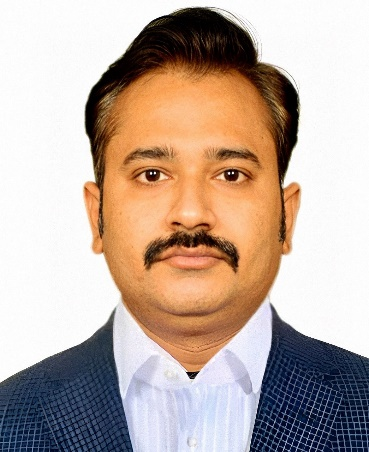Keynote Speech 1:
Welding of Inconel 718 alloy: Controlling Laves phase evolution and enhancing the mechanical performance of welded joints

Tushar Madhukar Sonar,
Professor, Department of Welding Engineering, Institute of Engineering and Technology South Ural State University, Russia
Biography:
Dr. Tushar Sonar is working as a Senior Research Scientist in the Department of Welding Engineering, South Ural State University (National Research University), Chelyabinsk, Russia. He completed his Ph.D. in Manufacturing Engineering (Welding) from Annamalai University in the year 2021. He is a recipient of the prestigious ISRO RESPOND research fellowship for the years 2017 to 2021. He has published more than 80 research papers in reputed journals and presented 18 research papers at many international conferences in countries including India, Russia, China, Spain and Greece. He is serving as the guest editor for International Journal on Interactive Design and Manufacturing (Scopus and ESCI indexed, Impact factor: 2.1) and editorial board member for Frontiers in Materials Science (Scopus/SCIE indexed, Impact factor: 3.2), Advances in Materials Science and Engineering (Scopus indexed) and Journal of the Mechanical Behavior of Materials (Scopus/ESCI indexed, Impact factor: 1.8) and as reviewer for many reputed international journals including Journal of Alloys and Compounds, Materials Science and Engineering A, Journal of Manufacturing Processes, Materials Characterization, Materials Today Communication, Intermetallics, International Journal of Refractory Metals and Hard Materials etc. He has total of 08 years of research work experience. He is also serving as Technical Program Committee member for the conferences: MMRCE 2024 to be held at Chongqing China and ICEIM 2024 to be held at Tokyo Japan. His research interest included welding and joining, additive manufacturing, surfacing, coating, corrosion, superalloys and high entropy alloys.
Abstract:
Inconel 718 is a nickel-ferrous-chromium based superalloy extensively used in the industrial sector at elevated temperature up to 650oC owing to its better mechanical properties and weldability. However, it is susceptible to some metallurgical problems during welding such as constitutional segregation and consequential laves phase formation in fusion zone (FZ) which severely deteriorates the service performance of Inconel 718 alloy joints. This alloy also reveals extreme tendency to microfissuring in heat affected zone (HAZ) owing to the eutectic phases and carbides developed at the grain boundaries. It causes the premature failure of welded aero-engine components. The gas tungsten arc welding (GTAW) process is comprehensively employed for welding of Inconel 718 alloy to produce high-quality joints. However, the high heat input and lower joint penetration associated with wider bell-shaped arc column principally constrains its applications and employability in making the highly efficient joint. The laves phase formation and HAZ microfissuring can be mitigated by lowering the heat input and increasing the rate of cooling. The electron beam (EBW) and laser beam (LBW) welding have shown significant influence on minimizing the laves phase formation, but they are susceptible to porosity related defects and liquation cracking owing to the rapid rate of cooling. This presentation provides an overview of the weldability studies on Inconel 718 alloy. The physical metallurgy of Inconel 718 alloy is explained briefly. The effect of welding processes (GTAW, EBW and LBW) and post weld heat treatment (PWHT) on microstructure and mechanical properties of Inconel 718 alloy joints is discussed.
Keynote Speech 2:
Communication-free Control Schemes for Dynamic Wireless Power Transfer System

Yun Yang, IEEE Senior Member,
Assistant Professor, School of Electrical & Electronic Engineering, Nanyang Technological University, Singapore
Biography:
Yun Yang received B.Sc. degree in Electrical Engineering from Wuhan University, China, in 2012 and Ph.D. degree in Electrical Engineering from the University of Hong Kong, Hong Kong, in 2017. He was a Research Assistant Professor with the Department of Electrical Engineering, The Hong Kong Polytechnic University. He is currently an Assistant Professor with the School of Electrical and Electronic Engineering, Nanyang Technological University. Dr. Yang served as an Associate Editors of several renowned journals and a Technical Committee Member of several renowned conferences. He published more than 80 technical papers, including 45 top-tier journals. He holds five patents. He is listed among the top 2% most-cited scientists in a global list released by the prestigious Stanford University in 2023. His research interests include wireless power transfer, power electronics, renewable energy technologies, electric vehicles, and advanced control.

Kaiwen Chen, IEEE Member,
Postdoctor, Department of Electrical and Electronics Engineering, Hong Kong Polytechnic University, Hong Kong
Biography:
Kaiwen Chen was born in Zhejiang, China. He received his B.Eng degree in Harbin Institute of Technology, China, in 2016. He received the M.Sc and Ph.D degree in Hong Kong Polytechnic University, Hong Kong, in 2017 and 2022. Currently, he is working as Postdoctoral Research Fellow in Power Electronics Research Centre, Department of Electrical Engineering, the Hong Kong Polytechnic University. He is also a Visiting Scholar in Nanyang Technological University. His main research interests includes dynamic wireless power transfer, electric vehicles and advanced control theory.
Abstract:
Since the varying charging state and the unpredictable movement of the power receivers, the monitoring of mutual inductance and load resistance is required in the controller for dynamic wireless power transfer system. However, the dual-side communication module is commonly introduced in the state parameter estimation, which increases the response time of the control loop. Several communication-free schemes with different control targets are proposed. The control targets include receiver positioning, zero-phase-angle operation, constant current/voltage charging and load-side disturbance damping.
